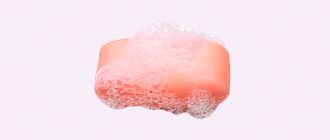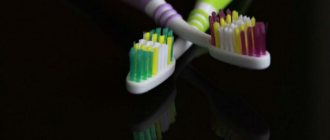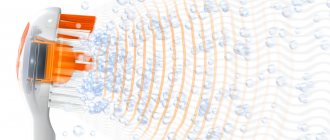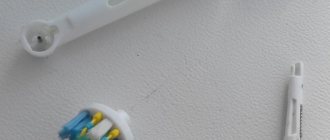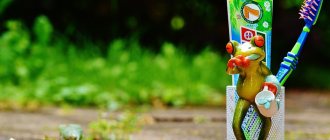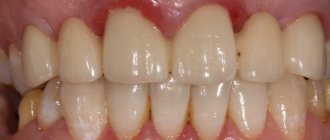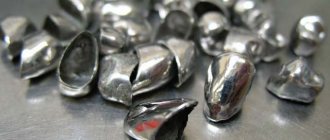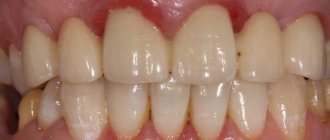Prevention of dental diseases begins with proper use of a toothbrush. It is important not only to have a good tool and brush your teeth regularly, but also to change it in a timely manner so that it does not turn from a means of protection into a risk factor.
Why do you need to change your toothbrush, how often should you do it and how to properly care for it? Information about all this is provided below.
Why you need to change your toothbrush
A brush used regularly, over time, not only loses its appearance and the original elasticity of the bristles, but also becomes an accumulator of a large number of harmful bacteria transferred from the surface of the teeth and gums. With short-term use, the density of bacterial accumulation is not too high and cannot cause harm. After some time, bacteria accumulate and can “relocate” back to the surface being cleaned, creating the risk of developing many negative consequences. Bristles that have lost their elasticity not only contribute to this transfer, but can also become a traumatic factor for the gums, further aggravating the current situation.
the most acceptable period for changing a toothbrush to be 3 months. If necessary, a replacement can be made earlier than the specified time, but it is highly undesirable to postpone the purchase of hygiene products for a longer period.
How to store?
To store this important item, you should adhere to the following rules:
- Use an individual cup or a special holder. Under no circumstances should you place the brushes of all family members in one container. This way they will come into contact with the bristles, and pathogenic microbes from one brush will end up on the other. When brushing teeth, a healthy person will become infected from a sick person.
- It is not advisable to store a toothbrush in a cabinet located in the bathroom. Lack of light, humidity, elevated temperatures and poor air circulation contribute to the appearance of mold.
- Please note that in a shared bathroom, the brush should not be located next to the toilet . When washed off, it will get splashed with germs, which is not at all hygienic and can lead to the development of various diseases.
- In the container or holder, the toothbrush should be in an upright position, with the bristles facing up . This way the water will drain faster and pathogenic microbes will not have time to multiply.
- Of course, the holder or glass must be clean . If they become dirty, wash them with warm water and soap.
- You cannot put the cap on a wet brush. It is necessary to dry the bristles well first.
- It is recommended to use cases only when traveling. They do not allow air to pass through, so there is a risk of pathogenic microflora appearing.
Attention! The brush that will be placed in the case must be dry.
A toothbrush is a faithful assistant in keeping teeth and gums healthy. It is only necessary to change it once every three months so that accumulated microbes and damaged bristles do not lead to the development of caries, periodontal disease, stomatitis or gingivitis. It is also important to properly care for your brush and follow the rules for storing it.
How often should adults and children change their toothbrush?
For proper cleaning, many dentists recommend changing your toothbrush every 1-3 months. Natural bristles are the least resistant to wear and tear. Elastic fibers quickly break off and become frayed, becoming unsuitable for proper cleaning.
How often should an adult change their toothbrush?
In connection with the above information, adults need to change toothbrushes once every 1-2 months.
Thus, answering the question: how many times should you change your toothbrush , you can answer: 4-6 times a year. It is worth considering that the indicated amount may vary depending on the factors listed above.
How often should children change their toothbrush?
A child's first toothbrush is a silicone massager that fits on the finger. The use of this device is advisable during the period of eruption of the first teeth and provides not only their cleaning, but also massage of the gingival surface. After each use, the massager must be disinfected in a special solution, or by boiling. In this regard, we are not talking about the accumulation of pathogenic bacteria in this case. However, gum massagers need to be replaced every 3-4 months.
When a child reaches the age of 1 year, it becomes necessary to use a full-fledged toothbrush. The choice most often leans towards bristles made from synthetic materials, which are least susceptible to contamination by microorganisms, have high elasticity and are easier to process. Starting from the age of 2, brushing teeth with brushes that have both synthetic and natural bristles is acceptable. A child's toothbrush is replaced at the same frequency as for adult family members; therefore, children of this age should change their toothbrush once every 2-3 months.
Some more useful tips
If it is not changed in time, then instead of doing good, it will only cause harm. Such an item for cleaning teeth damages tooth enamel, promotes the spread of pathogenic microbes, and leads to inflammation of the gums.
Any thing or object becomes unusable during use. A toothbrush is no exception. While it is new, you can brush your teeth and remove plaque with it without any problems. After a certain time, the bristles on the toothbrush begin to wear out, break, become deformed and become shaggy.
It is already dangerous to take care of the oral cavity with such an instrument; it can damage teeth and gums. In addition, even if the brush looks good and has not lost its original appearance, but is used for a long time, pathogenic microflora still multiplies in the villi. It will definitely get into the mouth of the owner of the brush and provoke an inflammatory process and dental diseases.
Both adults and children should definitely brush their teeth. Parents brush their babies' first teeth using a silicone fingertip. It is very easy to use and easy to clean. The fingertip should be replaced with a new one as it wears out.
As the child gets older, he brushes his teeth with a brush that has bristles. When used, the bristles deteriorate, lose their original appearance and perform their function worse and worse. In addition, over time, pathogenic microbes begin to develop in the toothbrush.
The baby may develop caries, stomatitis, tonsillitis and other diseases. In order not to injure the child’s teeth and gums, as well as to avoid health problems, it is imperative to change the brush with a new one every two to three months, that is, 4-6 times a year.
Adults should monitor not only the health of their children, but also their own. A damaged and long-used personal toothbrush can cause serious damage to the gums and teeth of an adult. As a result, you will have to undergo long and persistent treatment.
Most toothbrushes have colored bristles, which act as an indicator. With daily brushing of teeth twice a day, the multi-colored bristles begin to discolor after about three months. This is a signal - it's time to replace the brush with a new one. Continued use may be hazardous to health. You should change your toothbrush if:
- heavily polluted;
- has an unpleasant odor;
- cracked;
- The bristles have fallen off or lost their shape.
The most effective way to clean your teeth from food debris and plaque is with an electric toothbrush. It comes with a variety of replacement cleaning attachments. If there are not enough attachments, they can be purchased separately.
With use, the bristles on electric brushes also wear out, as evidenced by a tarnished indicator. This happens after about three months of using the device. In this case, you should immediately replace the cleaning head with a new one.
If your electric brush is not equipped with an indicator, you still need to change the brush head after three months of using the device. This will help keep the oral cavity clean and prevent the development of inflammatory processes.
- Over time, more and more pathogenic bacteria accumulate in the toothbrush. If it is not changed on time, serious problems with teeth and gums may occur. There is a high risk of diseases such as stomatitis, caries, periodontal disease or gingivitis.
- Bristles that are deformed due to prolonged use no longer effectively clean teeth and interdental spaces. They begin to damage tooth enamel and injure the gums to the point of bleeding.
- Old toothbrushes do not remove plaque from the surface of teeth well, which will subsequently lead to the formation of tartar and bad breath.
The service life of an individual brush is about three months if you care for it properly, namely:
- After brushing your teeth, rinse thoroughly under running water, shake and dry well.
- Do not boil, as artificial bristles become deformed when exposed to high temperatures.
- Do not press hard on the brush when brushing your teeth. This will lead to rapid deterioration of the bristles, as well as damage to tooth enamel and bleeding gums.
- Periodically place for 30 minutes in a soda or saline solution for disinfection. To prepare a disinfectant liquid, dissolve one teaspoon of soda or salt in a glass of warm boiled water.
- Sterilization can also be done using an ultraviolet lamp. Within 10 minutes, the sterilizer will destroy all germs.
How often should you change your electric toothbrush?
The electric toothbrush itself is designed for a long service life, estimated at several years and depending primarily on the performance of the motor performing the work. Cleaning attachments must be replaced regularly. It is recommended to change them in the same way as a regular brush, i.e. every 2-3 months, unless circumstances arise that require a reduction in the specified period (damage to the bristles, previous diseases, mold damage, etc.). This is due to the fact that the bristles for the attachments are made from the same materials as regular toothbrushes. Read more about the benefits and harms of electric toothbrushes here.
How to tell when your toothbrush needs to be replaced
The maximum period of use of even the best brush is 3-4 months. Even if it seems cleanable and looks good, it is still worth replacing. The main reasons for replacing your toothbrush are listed below:
- The service life of the brush exceeded 3 months;
- After suffering infectious diseases, to avoid re-infection;
- Wear of the bristles, their fraying, change in original color;
- Accumulation of plaque, visually noticeable on the surface;
- Use of a brush by another person;
- The appearance of signs of black mold infestation;
What happens if you don't replace your toothbrush on time?
A toothbrush used for more than several months, after a certain time, not only loses its aesthetic appeal, but can also become an object that can cause at least discomfort during use. In the worst case scenario, a toothbrush not replaced in a timely manner can cause many problems, such as:
- Injury to the gums and bleeding;
- Infection of soft tissues of the oral cavity;
- Development of gingivitis, periodontal disease and caries;
- Increased level of plaque accumulation;
- Unpleasant odor;
- Possibility of re-infection after illness;
- The risk of contracting a number of diseases if another person used the toothbrush.
In order for the toothbrush to fully and safely perform its functions during the permissible period of use, it is necessary to adhere to the rules of care and storage.
In what cases is it necessary to replace the brush ahead of schedule?
Toothbrush hygiene can increase the lifespan of your toothbrush. It is important to know how to care for a toothbrush, how to treat it and how to disinfect it. It is equally important to know when a device is due for premature replacement. In some cases, even if you take full care of your toothbrush, it should still be changed ahead of schedule:
- if other people use the personal device (more often this happens by accident);
- if the product falls on a dirty floor;
- any form of contamination in which even thorough cleaning of toothbrushes is ineffective;
- bristle wear;
- the appearance of an unpleasant odor;
- If you experience unpleasant sensations on your teeth or gums, this may indicate deformation of the bristles.
Rules for the care and storage of a toothbrush
- After each use, the toothbrush is thoroughly rinsed under running water. For better processing, you can rinse the brush in boiling water. However, prolonged contact with high temperatures can cause damage to the bristles;
- At least once a week, the brush must be treated with a disinfectant solution. An affordable and high-quality disinfectant is ordinary hydrogen peroxide;
- The toothbrush is stored in a container that has holes to drain any remaining water on the bristles. Otherwise, black mold, which is extremely dangerous to health, may form, both on the glass and on the toothbrush itself. The ideal option would be to dry the bristles and use special cases that have the ability to emit ultraviolet light;
- It is recommended to store the toothbrush covered in a special cap that protects the bristles from external influences.
Separately, you should pay attention to the hygiene products that were used during the trip or hospital stay. Such toothbrushes must be replaced with new ones immediately after returning home. This is due to the fact that under these conditions, the risk of bristle infection by various pathogens increases significantly.
In addition to proper storage of the brush, accuracy in its choice plays a big role.
Should I use an irrigator?
The irrigator thoroughly cleans the interdental spaces
Is a waterpik a substitute for a toothbrush? The principle of its operation is that under the influence of a certain pressure, food debris is washed out from the interdental spaces and hard-to-reach places.
The main advantages of the irrigator include:
- washing of periodontal pockets;
- delicate and thorough gum massage;
- reducing the risk of developing an inflammatory process.
Note! The irrigator does not replace a toothbrush. It cannot cope with old plaque and is used only as an additional hygiene product.
Main types
Dentists distinguish 2 types of irrigators: portable and stationary. The first has an impressive water tank. It is also called family friendly because all family members can use it. This device operates from the electrical network.
The portable irrigator is battery powered. It has a small liquid reservoir. The power of water pressure can be easily adjusted.
Attachments for the device
The plate lists the main types of irrigator attachments.
Table 3. Basic attachments for the device.
| Type of nozzle | Description |
| Intended for the treatment of periodontal pockets. To avoid discomfort, the power should be adjusted. |
| Located closer to the root. It is advisable to start cleaning with minimal power. |
| Intended for treating areas in the area of implants. |
How to choose the right toothbrush
Bristle hardness
Manufacturers offer bristles of 3 types of hardness:
- Soft. Suitable for children and people suffering from gum disease that causes bleeding and pain;
- Medium hardness. It is a classic option, most popular among consumers. This is explained by the optimal balance between a delicate attitude during processing and good cleaning quality. Such bristles are suitable for both natural teeth and most types of dentures;
- Tough. High-stiffness bristles should only be used on the recommendation of a doctor. As a rule, an indication for the use of such brushes may be excessively increased formation of dental plaque.
Location and shape of bristles
Angled, beveled bristles remove plaque more effectively and allow you to thoroughly clean your molars. Multi-level trimming of the bristles allows you to clean the side surfaces of the teeth and penetrate even into narrow spaces. The presence of oblique beams increases the coverage area and extends, including to the area of the tooth neck.
What brush should you use?
The table presents the best toothbrushes that can last a long time and with high quality.
Table 4. Which brush is recommended to choose?
| Manufacturer | Description |
| It is recommended to use an ionic product. It is activated when a person touches the handle with wet fingers. Using a product from SPLAT, the polarity of teeth is changed. Negatively charged particles of bacterial plaque are attracted to the bristles. The degree of bristle hardness is medium. |
| Manual device. Has a triple polishing effect. Another advantage is the style of the brush. The degree of stiffness of the bristles is moderate. Its ends remain smooth for a long time. |
| Dentists recommend that people with sensitive teeth and gums use a new product whose bristles are impregnated with pine phytoncides. Its use promotes rapid healing of gums. The degree of stiffness of the bristles is moderate. |
| The device is equipped with revolutionary Tynex bristles. Thanks to this, pigmented plaque can be easily removed when brushing your teeth. On the side of the head there are microtwister bristles that promote gentle enamel whitening. When using a paste from the same manufacturer at the same time, it lightens by 1.5 tones. |
The price of dentist-recommended toothbrushes is shown in the chart.
The price of the best hygiene products recommended by dentists varies from 231 to 779 rubles
